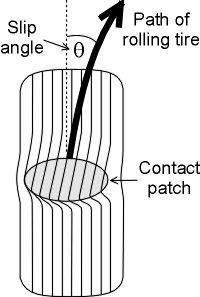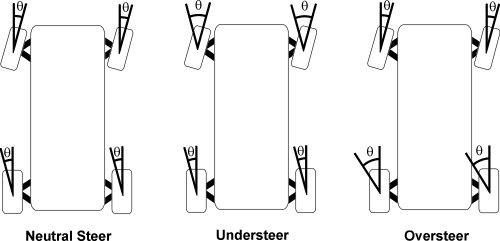You must be logged in to rate content!
5 minute(s) of a 612 minute read
4-12-2009
The alignment changes in my Turbo are geared largely, almost singularly, towards reducing understeer. Following is a nice discussion why cars understeer or oversteer: http://www.autozine.org/technical_sc...handling_4.htm . The concept of slip angle is explained and emphasized.
(Found on the net:If you see the tree before you hit it it's called understeer; if you only hear and feel the tree it's oversteer. ![]() ) Anyway, here's part of the article:
) Anyway, here's part of the article:
Neutral / Understeer / Oversteer
We often hear these 3 terms in car magazines. I think few people would argue if I say they are the most important elements in the study of handling. What is understeer ? Basically, if you turn the steering wheel and find the car steers less than you expect, the car is understeering. This is not because your subjective judgement goes wrong, in fact any car must have some degree of non-neutral steering due to the weight distribution, suspension design, tyre used, lateral acceleration and road conditions. Further more, a car could understeer in this corner and then oversteer in that corner. The whole picture is very complicated, so I'll spend more paragraphs to discuss this topic.
What do we need ?
It seems that neutral steer must be more desirable than understeer and oversteer, but in fact it is not. In fact, when running in straight line, we want a little bit understeer to make the car stable. When the car is subjected to side force, probably due to cross wind or the road's irregularities, understeer could resist the force and avoid the car to be steered automatically, therefore the driver need not to correct the steering frequently.
When the car is entering a corner, we also need a light understeer to provide the stability while the driver is easing off the brakes and building up cornering force. In mid corner, we need neutral steer. In the exit phase, a slight oversteer will be welcomed as it helps tightening the path. However, the degree of oversteer must be progressive and easily controllable by applying and easing throttle. We call this "Power Oversteer". Without power oversteer, we have to ease the throttle (thus loss time) or the car will run out of the corner.
However, I must make clear that what I say "slight understeer / oversteer" is usually deemed to be "near neutral steer" by most car magazines. This is because in reality there are too many cars running on severe understeer thus they used to them. In other words, if a car magazine said the Porsche 996 has mild understeer, it probably equals to "medium understeer" in our sense.
Basic Concept : Slip Angle
Before going on our study, we must understand the concept of slip angle first. When a car enters a corner, all the tyres are turned with respect to the ground. Due to the elasticity of the pneumatic tyre, the tread in the contact patch will resist the turning action because there is friction generated between the rubber and the road surface. As a result, the treads on the contact patch will be distorted, whose direction always lags behind the direction of the wheel ( See figure in below ). We call the angular difference between the treads and the wheel's direction as Slip Angle.
 Note : the car is turning left
Note : the car is turning left
In which direction the wheel is running ? It is the direction of the tread, not the direciton of the wheel. I am not saying the tread has any ability to force the wheel to travel in its direction. On the contrary, the tread is only a sign showing how an arbitrary point on the tyre surface travels. If the arbitrary point travels in that direction, so does the wheel which is the summation of thousands of those points. Now you must think the existence of slip angle must reduce the car's steering angle thus leads to understeer. In fact, it is not so if everything else are perfect. Because both the front and rear tyres have more or less the same slip angles, they counter each other thus the resulting steering angle remains unaltered.
However, if the front and rear wheels have different slip angles, then we get understeer and oversteer :
Understeer : Front Slip Angle > Rear Slip Angle
Oversteer : Front Slip Angle < Rear Slip Angle
Neutral steer : Front Slip Angle = Rear Slip Angle

